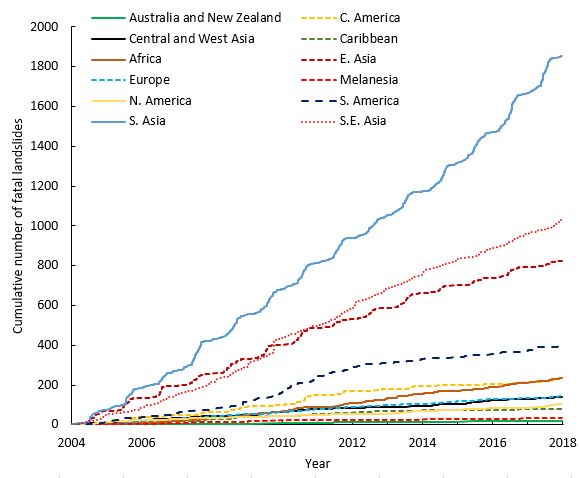5 February 2020
The geographical spread of fatal landslides
Posted by Dave Petley
The geographical spread of fatal landslides
I have been writing my paper for my keynote lecture at the forthcoming 13th International Symposium on Landslides, which will be held in Cartagena in Colombia in June this year. I was asked by the organisers to talk about landslides and less developed countries, a topic of great importance. As part of that paper I have gone back to the fatal landslides database once again to look at the geographical spread of landslides around the world. The data I have been collecting (for over 17 years) is focused on landslides that cause loss of life; for this type of analysis I usually exclude landslides associated with earthquakes (which is a different but very interesting topic). So, for the paper I have prepared a graph showing the cumulative number of fatal landslides by geographical area, covering the period from January 2004 to December 2017 inclusive:-

The cumulative number of landslides by geographical area from 2004 to 2017 inclusive.
.
There are many interesting aspects of this data, of which I have written previously, but that are neatly synthesised in this graph. First, and most obviously, it is South Asia that suffers the greatest number of fatal landslides. That is well-established now, but only a decade or so ago people were maintaining that this was not the case, based on the use of less comprehensive datasets. Second, really significant losses also occur in Southeast Asia and in East Asia, and to a lesser extent in South America. The other geographical areas contribute relatively few to the global total.
The data also shows the strong seasonality in some areas, with stepped rather than linear trends. This is clear for South Asia and East Asia, showing the influence of the summer monsoon.
But there is also something here that I had not noticed before. The South America data shows a strange trend in that there was a notably higher landslide rate in the period 2009 to 2012 than in the periods before and after. I am not sure as to the causes of this. Is it a data issue or was there really a change in landslide occurrence in that period? That requires further investigation.
And finally, hidden in the data is an interesting trend in the data for Africa. Whilst the overall number of recorded landslides is low (probably too low in reality, suggesting that not all events are being captured), the general trend is accelerating dramatically. This is of significant concern.
Sources
The data are described in detail in Petley (2012) and Froude and Petley (2018), and in the associated blog posts.
References
Froude, M. J. and Petley, D. N. 2018. Global fatal landslide occurrence from 2004 to 2016. Natural Hazards and Earth System Sciences, 18, 2161-2181, https://doi.org/10.5194/nhess-18-2161-2018.
Petley, D.N. 2012. Global patterns of loss of life from landslides. Geology 40 (10), 927-930.


 Dave Petley is the Vice-Chancellor of the University of Hull in the United Kingdom. His blog provides commentary and analysis of landslide events occurring worldwide, including the landslides themselves, latest research, and conferences and meetings.
Dave Petley is the Vice-Chancellor of the University of Hull in the United Kingdom. His blog provides commentary and analysis of landslide events occurring worldwide, including the landslides themselves, latest research, and conferences and meetings.
Respecto a “Los datos de América del Sur muestran una tendencia extraña en que hubo una tasa de deslizamientos de tierra notablemente más alta en el período 2009 a 2012 que en los períodos anteriores y posteriores” en Colombia durante esos años se aumento el numero de deslizamientos asociado al evento NIÑA, el cual fue muy marcado durante 2010-201.
Corrección ENSO 2010-2011